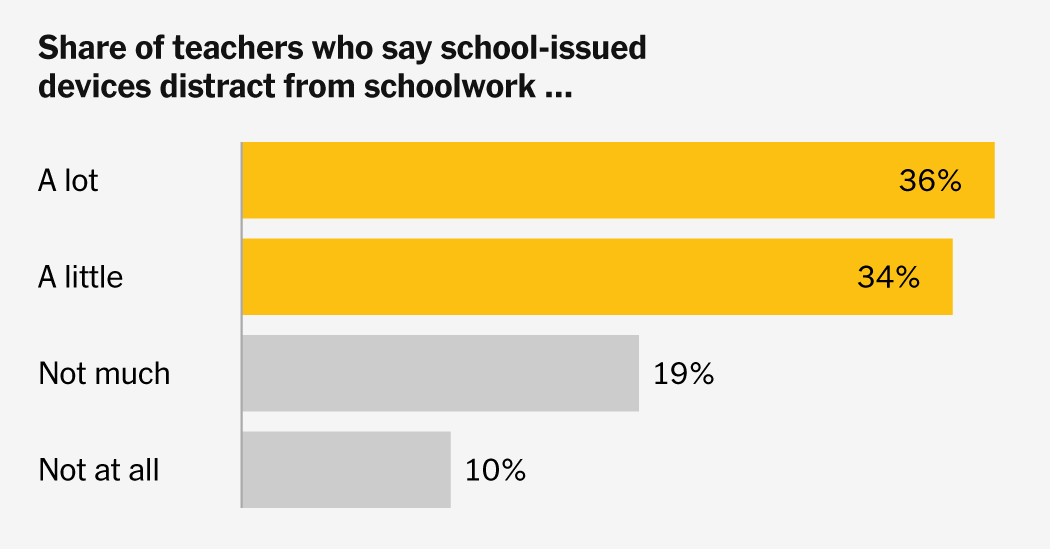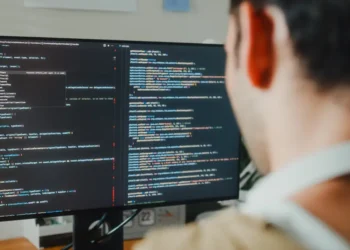American classrooms have been transformed by screens in the last five years, with most students, of all ages, now learning on computers or tablets during the school day.
Even as schools have moved rapidly to ban cellphones, screens are nearly universal: Ninety-nine percent of teachers said their school provided devices to students for use in class, in an informal national survey of 350 pre-K through 12th-grade teachers conducted by The New York Times in October.
Eight in 10 teachers said students at their school had a device assigned to them, compared with about a third who said that was the case in 2019 before the pandemic.
And of elementary schoolteachers, 81 percent said students at their school receive devices for use in class by kindergarten.
In a separate Times questionnaire, sent to the 20 largest U.S. school districts, nearly all said they provide devices to students starting in kindergarten or earlier.
The results show how technology has become ingrained in schools, with computers often used for required curriculum, standardized testing and even free time. Google Chromebooks are the most common device.
Online learning has brought important benefits, teachers said, like preparing students to use technology in their future careers, and enabling them to research topics online.
But it has also introduced new problems, with concerns about distraction and screen time mounting among both teachers and parents as U.S. test scores decline.
In the survey, which included respondents from 40 states and Washington, D.C., nearly three-fourths of teachers who use devices in their classrooms said they distract from student learning and engagement in class, and a majority said children in their classrooms had used them to play games or watch videos unrelated to school.
Still, about seven in 10 teachers said that if it were up to them, they would choose to use devices in their class at least some of the time.
“It’s not either/or for me,” said Bill Heuisler, a high school history teacher in Los Angeles. “It’s about wisely using technology” only when necessary, he said.
A pandemic shift, for the long haul
Many schools began providing laptops to students in the 2010s. But the vast embrace of technology, for students of all ages, accelerated because of the pandemic.
When schools went remote in 2020, districts across the country rushed to buy every student a personal device, and the business of education tech exploded, with districts investing in online apps and curriculums.
In the survey, about half of teachers said their school’s core curriculum required students to work online.
More than two-thirds said student work time on devices had increased from prepandemic levels.
In elementary classrooms, most teachers estimated that students use them for an hour or less a day. The youngest students, unable to read or type, listen on headphones and use touch screens, teachers said, and need exposure to devices because most standardized tests are now given online.
Karissa Mallory’s first graders in Detroit use devices to take district tests and to work with an A.I. tutor on their reading skills.
Three- and four-year-olds in Lupita Villalobos’s district in Duncanville, Texas, use iPads to play learning games or listen to stories, she said. But she has opted out of using them in her own pre-K classroom, because she finds that children this age learn better through hands-on, play-based activities.
In middle and high schools, four in 10 teachers said students spend three hours or more a day on devices. Cedric Jacobson, a high school teacher in Boston, said students use devices in science to see interactive simulations; in math to do practice sets that adapt to their level; and in the humanities to draft and revise work.
They offer “tremendous potential to advance student learning and understanding,” he said. But he has also observed that students have become less persistent in searching for answers, “blindly trusting” what they find on Google or A.I. chatbots.
In the district questionnaire, officials from the largest school districts said technology was a key to their academic and equity goals. They said devices can offer students individualized lessons at their level, provide real-time translation for students learning English — 10 percent of the U.S. school population — and support students from low-income families, who may not have access to a computer at home.
“Access to reliable technology and high-speed internet is a modern-day necessity, and, right now, too many New York City students don’t have it,” Mayor Eric Adams, who oversees the nation’s largest school district, said while announcing 350,000 new Chromebooks, equipped with 5G internet, for students this fall.
Yet even as schoolwork moves online, schools rarely teach students basic digital skills. Less than one-fifth of teachers surveyed said their districts taught students to type proficiently.
Roughly 80 percent of teachers said their district provided Chromebooks for students. The second-most common device was an iPad.
Andy Russell, a product manager at Google who oversees Chromebooks in schools, envisions them ushering in a new era of education — one in which teachers aren’t lecturing in front of the room, but rather acting as facilitators to students learning on computers and using online tools to creatively show what they’ve learned.
“So much of what teaching is today is not the when and the what, like I learned; it’s a lot more of the how — this is how we make a video, this is how we build infographics,” he said.
He said Google had heard from teachers that distractions were a problem. Last month, Google began offering them new tools, including the ability to see live feeds of students’ screens and to lock screens so students can’t do anything other than the assigned lesson.
It also automatically disables YouTube on educational accounts and allows schools to set devices to turn off at a certain time at night. (Many districts choose to allow YouTube, and just 4 percent of teachers surveyed said their school put screen time limits on devices.)
Teachers on the benefits …
Overall, teachers expressed mixed feelings about devices. They said devices had made grading easier, allowed them to give real-time feedback to students and supported their ability to work with small groups, while others worked independently online.
… and the downsides
Many teachers also have deep concerns.
Though nearly all said their schools used content blockers, students often find ways around them.
Increasingly, teachers said, students are also using A.I. to take shortcuts. Google search, the default on most Chromebooks, now presents A.I.-generated summaries at the top of search results, which some teachers said discourages students from digging deeper.
Many teachers worry that computers at school simply add to this generation’s total screen time. Teachers described students with weakened spelling and handwriting skills, diminished imaginations and less stamina to focus on arduous tasks that are not as engaging as apps that make lessons into video games.
Growing concern
There is little evidence from high-quality studies on how technology affects students’ outcomes.
Some teachers and parents are pushing back.
For parents, school-issued laptops, which often come home, especially with older students, are yet another screen they have to monitor — and one largely outside their control.
“You have this extremely powerful technology that is designed to be addictive,” said Miriam Kendall, the founder of a parent group called Screen Sense Evanston, which is pressing the school district in Evanston, Ill., to establish screen-time limits during the school day and reduce sending devices home.
The district announced earlier this year that it would remove YouTube from student devices.
Some teachers have begun using devices only when essential, and returning to pencil and paper for everything else.
“I will be the first to admit, I was swept up in the ed tech craze earlier in my career, but the payoff has not been there,” said Jill Anderson, a third-grade teacher in Ossining, N.Y., who said she was “devastated” about the effects of computers in classrooms.
This year, she is limiting devices to required tests, students’ final writing assignment and a lesson on technology.
Kathleen Price, who teaches middle school English in Charlotte, N.C., said students in her class read paper books, write by hand and use red pens and highlighters to annotate text. “I think they actually love having a break from screens and getting a chance to engage in deep reading, discussion and activities,” she said.
Produced by Alice Fang. Graphics by Francesca Paris.
Claire Cain Miller is a Times reporter covering gender, families and education.
The post The Upshot appeared first on New York Times.




